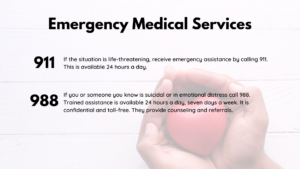Chapter 14: Emergency Services and Treatment
Emergency Services
First, it may be beneficial to save the image below for future reference. If you or someone you needs emergency services, use these numbers in the United States.

If you need help finding treatment the Substance Abuse and Mental Health Services Administration (SAMHSA) offers a behavioral health treatment services locator. The information entered is fully anonymous and secure. Select the picture below to be directed to this service or follow this link.

Treatment
There are different types of mental health crisis services available: 24-hour crisis lines, walk-in crisis services, and mobile crisis teams. 24-hour services are generally the first point of contact for a person in need of assistance. Walk-in services are urgent care centers that are set up like a hospital emergency room, but are less intensive. They can sometimes act as drop-off centers for law enforcement to decrease arrests. Mobile teams are those than work closely with law enforcement, hotlines, and hospital emergency staff. These teams can identify if someone needs admitted or can connect them with community programs (NAMI, 2022).
There are other opportunities for treatment as well, beyond emergency crisis services. Follow this link to NAMI for full information, a summary is below.
- Respite Care and Residential Services
- Family-based crisis home support
- Crisis respite centers and apartments
- In-home support
- Crisis Stabilization Units
- Extended Observation Units (23-hour beds)
- Hospitalization
- Partial Hospitalization
- Day Hospitalization
What to do in a crisis?
Evaluate the Situation.
- Do you or someone you love need urgent treatment?
- If there is a plan to kill yourself: call 911 or go to the emergency room immediately.
- Unsure? If you answer yes to any of these, then call 911 or go to the emergency room.
- Urgent thoughts planning it
- Method is determined
- Where, how, or when are determined
- If you are hesitating, ask someone close to your to support you.
- Call the National Suicide Prevention Hotline: 18.800.273.8255
- They are available 24/7
- Contact mental health professionals immediately.
Avoiding a Crisis: Download this Guide from NAMI
References:
Mental Health (2022). Get immediate health. https://www.mentalhealth.gov/get-help/immediate-help
National Alliance on Mental Illness (2022). Getting treatment during a crisis. https://www.nami.org/Learn-More/Treatment/Getting-Treatment-During-a-Crisis
National Alliance on Mental Illness (2022). Navigating a mental health crisis. https://www.nami.org/Support-Education/Publications-Reports/Guides/Navigating-a-Mental-Health-Crisis
Substance Abuse and Mental Health Services Administration (2022). SAMHSA’s national hotline. https://www.nami.org/Support-Education/Publications-Reports/Guides/Navigating-a-Mental-Health-Crisis/Navigating-A-Mental-Health-Crisis?utm_source=website&utm_medium=cta&utm_campaign=crisisguide
Substance Abuse and Mental Health Services Administration (2022). Behavioral health treatment services locator. https://findtreatment.samhsa.gov/

